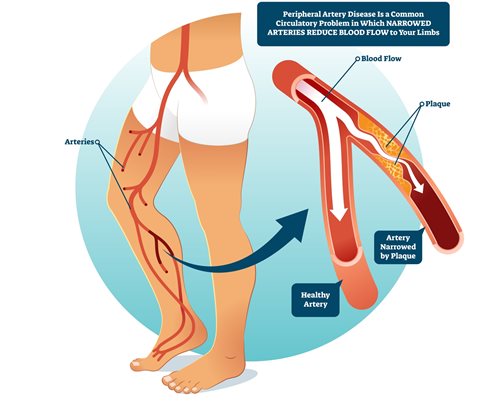Peripheral arterial disease, commonly called PAD, is a medical condition that affects millions of Americans. Yet, despite more than 8.5 million people in this country being diagnosed with PAD, it’s believed to be widely under-diagnosed. Identifying PAD early can not only help relieve painful symptoms, it can also help avoid potentially serious complications.

PAD is a condition that affects the circulatory system. “It’s caused by plaque buildup in the arteries, a process called atherosclerosis. This buildup eventually narrows the arteries and reduces blood flow to the limbs,” explains Pamela Meyer, RN, MS, APRN, FNP-C, CNOR, a nurse practitioner at Catholic Medical Center’s Surgical Care Group. PAD most commonly affects the legs, where most of the symptoms can be seen and felt.

“Reduced blood flow means reduced oxygen to the tissues of the legs,” says Meyer, “so in addition to cramping or pain during normal activities (walking, climbing stairs, etc.), you may notice shiny skin, decreased pulses in the feet, a change in skin color on the legs or feet, cool feet, or even toe nails that are slow to grow.”
As PAD progresses, symptoms may also be felt when someone is resting, with their feet elevated. Pain is relieved by putting the foot over the side of the bed or getting up to walk around. This is known as ischemic rest pain and is localized in the feet or toes. “By this point, you’re likely to notice changes in your skin in addition to the pain, like your feet appearing blue or even sores that won’t heal or the onset of gangrene,” Meyer says.
In addition to other conditions associated with atherosclerosis such as heart disease and stroke, there are several risk factors that may lead someone to develop PAD in the legs:
- History of or current tobacco use, to include cigars, pipes and e cigarettes
- High blood pressure
- Diabetes
- High cholesterol
- Age over 60
- History of heart and kidney disease associated with arteriosclerosis, or a family history of arthrosclerosis
Additionally, people of African-American or Hispanic ethnicity are at a slightly higher risk for developing PAD as are men.
Diagnosing PAD is a painless process that consists of a physical examination and blood pressure measurements (the ankle-brachial index). In some cases an ultrasound of the legs will be ordered as well.
Treating PAD depends on the type and severity of a person’s symptoms. Options can range from lifestyle, diet, medications and exercise to interventions like angioplasty, stenting or surgery.
“PAD is often referred to as a silent disease,” says Meyer, “but it doesn’t have to be. Screening is easy and the treatment options are many, especially if it’s caught early. This disease does not have to keep you from living your best.”
For additional information on PAD screenings, please call the Surgical Care Group:
603.627.1887